Good morning/afternoon/evening/night my international friends, especially the one in Namibia, you lucky devil. How I covet your vast range of bulbous oddities, from the subtle grace of your wild Gladioli, through the Iris-like sex appeal of your many Moraeas to the bizarre, such as the Lachenalia, a plant that looks the a hyacinth after a trip to the Dr Who props department. You can keep the Skeleton Coast though.
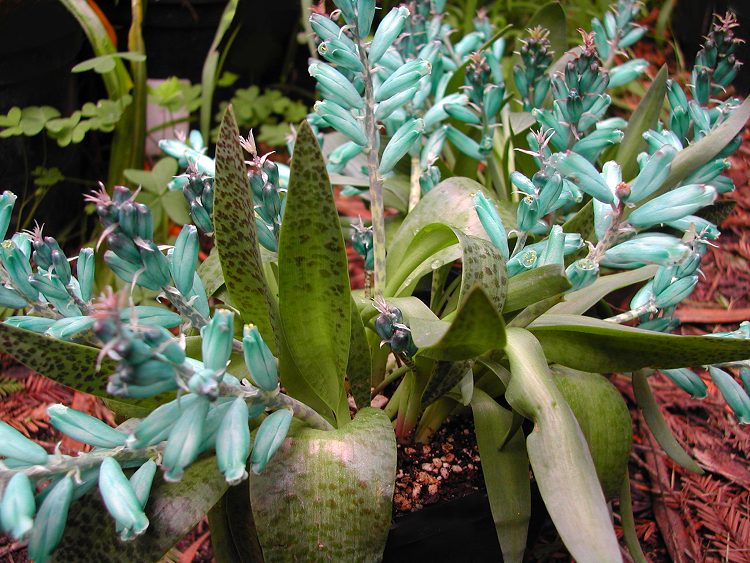 |
This is a particularly weird and wonderful example of Lachenalia viridiflora, one I'm trying from seed, despite having no means of getting the young bulbs through even the mildest of our winters. There is only room at the bottom of the stairs for three pots. And that's assuming either of my pots of five seeds each do any germinating (that's the problem with South African seed dealers, you do get literally five seeds per packet. The Lachenalia comes in many other colours, a few of which I'm trying but it's pouring with rain and I've just been out with the camera so I'm not going out again to scrutinise labels. I probably haven't sown them yet anyway, a lot of southern African plants flower during their winter which is when the rains fall but we don't really have an equivalent season, our wet winters being too cold. And it's not winter in the UK when it's winter in Namibia. So five seeds is not really enough to experiment with but they're not cheap so I'll have to make do. Photograph copyright: Strange Wonderful Things.
|
 |
| Strange and beautiful: L. mutabilis |
As regular readers will know, I'm trying my hand at all three (Gladiolus, Moraea and Lachenalia) , from seed mostly, plus many others from southern Africa. This despite having no heated greenhouse, and an indoor heated propagator that I amazingly persuaded my other half to let me use in my own house but which is on the only surface on the entire wall that doesn't get direct sunlight.
So when things germinate it's a race to hoy them outside under a hastily devised cloche where they are at least protected from the biting wind (it is technically winter) and have sun from all sides.
So far only the Schizanthus grahamii has gone too leggy to make it as the others are monocots (this means only one seed leaf children, like a blade of grass, only tucked round in an inverted "U" shape during germination, after which the end that doesn't have any roots on it will eventually straighten up to give a single leaf, called the seed-leaf). Anyway, the point is they get outside while still bent over so they have no chance the go leggy (too much stem before the first pair of leaves) and rot off.
 |
| Copyright Leo Breman |
I can claim success with Gladiolus undulatus, that fairy bells thing, no, not the Disporum one, although I have that as a mature specimen, the one with the incredibly long and unmemorable name, hang on … Melasphaerula ramosa, Dipcadi serotinum and Alonsoa "Bright Spark". But far more remarkable are the two outdoor successes: Moraea ciliata – which had nothing more than a clear polythene bag to encourage germination – and Gladiolus watermeyeri which is in the cold "greenhouse" but I've been leaving that open at night to try to resolve a bit of a mould and possible fungus problem so it affords almost no protection from the elements (mind you, it's little better when zipped up. It's like the difference between a sweater and a cardigan).
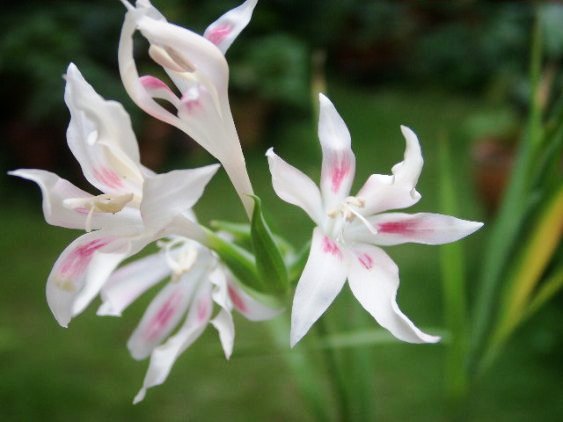 |
| Gladiolus undulatus. Mine's a bit smaller than this... |
 |
| G. Watermeyeri. I think this might be one of the rainy season group |
 |
| The snappily titled Melasphaerula ramosa, or one of several plants called Fairy Bells |
 |
| Dipcadi Serotinus. My seeds are romping away. There does seem to be a direct correlation between the attractiveness of the plant and the ease of growth. No, it's intersting rather than ugly. |
_(Scrophulariaceae)_Flower.JPG) |
| Alonsoa is one of my first batch of Chilean babies, which I've only had a couple of weeks so it's clearly happy. The species range from pink to deep red and look a bit like Diascias |
However, since I moved my 30 or so Lewisia Cotyledon "Sunset Strain" seedlings in there, not only have I stopped kicking them over and made some space in the process, they have started romping away, possibly even to the extent that I might get some to flower this year, which would be handy cos of course I will give most away I want to keep the best colour combinations for myself. I'm especially keen to have a yellow. I have been taking care to spray both seedlings and the ungerminated with fungicide at fortnightly intervals (according to the instructions on the bottle) and think this has saved some of the nameless species pelargoniums in the process).
 |
| My crappy little "greenhouse" from Argos. It's all I can fit up here and will do the least damage to neighbouring properties in the event of a small gust of wind. The top layer consists of Lewisias on the left and seeds and a seedling on the right. The bottom is a mixed bag of pelargoniums, more seeds and the green pot contains seeds of Narcissus serotinus which are germinating fine but then growing painfully slowly, many still with their seed shells still clinging to the top of their cotyledons. |
 |
| The Lewisia Cotyledons have thanked me for lifting them off the constantly wet and muddy roof surface by sitting up, looking sharp and getting on with some proper growing |
 |
| A nice yellow would be great. And the chances getting one must be quite high with almost 30 plants. |
 |
| It doesn't look much but Lilium concolor ssp strictum means a lot to me as getting hold of bulbs has so far proved impossible and it's a dinky little thing that would go nicely with my other 50 or so species |

As you know, I'm experimenting with seed from Chilean plants as much of the Andean climate rarely outperforms our own, despite being considerably closer to the sun. But there's about the same amount of clean air up there as there is in London. I'm experimenting with a new method of sowing the smaller seeds: JI no1 and a bit of grit (these are mostly alpines, in the true sense [well, different continent but you know what I mean]) with the seed (just a dozen or so of the bigger ones, impossible to count the wee ones) carefully distributed on the surface and then a thin layer of 4mm grit (aquarium supply shops sell it in sensible quantities but be careful with the pH; I almost walked out of the shop with a bag of crushed sea shells, I might as well have used pure lime). And I mean thin layer, one or two stones deep. So you have light, moisture and you know how deeply the seed is planted.

The exception is Tropaeolums(ae?) which should be buried as they need darkness to germinate and tend to be on the large side. A 72-hour soaking or careful scarification with a blade to let in moisture will either speed up germination by letting in moisture more quickly or kill the embryo, depending on your knife skills.
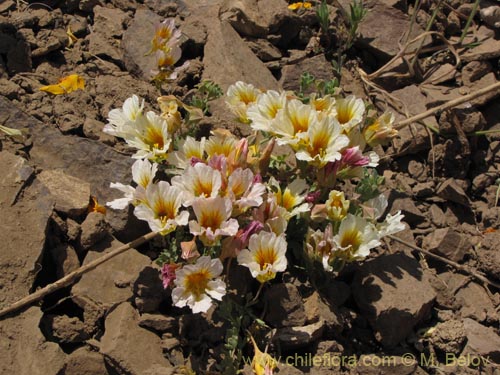 |
| Not your average Nasturtium. Tropaeolum needs dark and heat to germinate and hates root disturbance but as I don't know where I'm going to put then yet, they are in a wide pot on top of the propagator indoors |
I've just planted a pot of T. sessifolium after a good soak (I'm not a knife fan, tried it on a batch of Iris pseudacorus alba and not one of these less-than-challenging seeds has appeared.) However, while we're on Irises, I do have a single Iris attica through after only a couple of weeks.
 |
| I'm hoping for more than just one Iris attica seedling as they come in a huge variety of colours in nature, from blue to yellow and stunning combinations in between |

A lot of the Chilean seed was tiny so, having bought a bag of cleaned and neutral sand I was able to follow the Carol Klein method of mixing a little sand with the little specks of seed and, top tip here, using one of those paper liners you use for fairy cakes, you can use it form a V-shaped shute down which you tap the mixture, straight onto the top of the growing medium (don't pack it down too hard, just a few good taps to level it off) and the sand shows you exactly where you've been so you get an even distribution and pricking out such tiny seedlings becomes a challenge rather than an impossibility. I used this method for Mimulus naiandinus, seeds so small they would easily get into Heaven via the needle route. They were the smallest but the method was required for several others. On the Chilean side yesterday saw Herbertia lahue, Oxalis squamata, Solenomelus segethii, Calandria sp. 1212, Rhodophiala splendens, and the Tropaeolum. I also sowed Romulea monadelpha, Primulas fauri and wilsonii and some Helichrysums and Zinnias I got free to give to my friend Linda who has a blank canvas in south London to fill with a quick splash of colour while I craft the long-term vision.
 |
| Herbertia lahue |
 |
| Oxalis squamata |
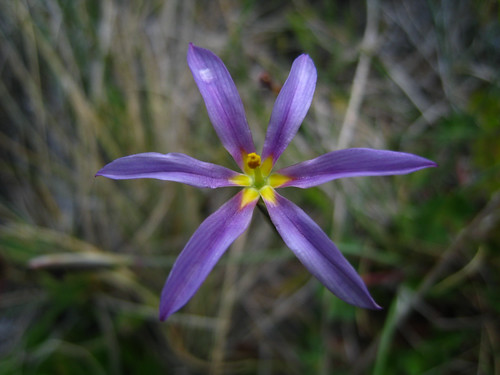 |
| Solenomelus segethii |
 |
| Rhodophiala splendens |
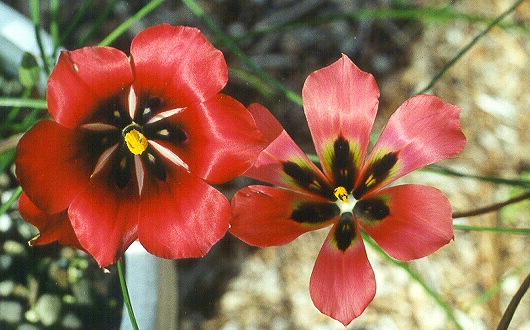 |
| Romulea monadelpha from South Africa, just to confuse you |
During the week three red Nerine sarniensis arrived, as did 10 Dichelostemma "Pink Diamond" and today four packs of labels I ordered a month ago from GardenCentre.co.uk actually arrived, one to avoid there I think, if they can't get the labels right I'd hate to buy their plants! Just as well another delivery of deliciousness from Lord Paul of Wrexham came: an amazing Gladiolus Saundersii that looked like a really chunky garlic bulb with last years stems (trimmed, of course) to show how deep to plant it, oh, new compost: JI3 with a bit of open humusy stuff, sand and plenty of grit and fertiliser granules because some of these things live in crevices (which I don't have), G. imbricatus, Moraea Robusta, again a really nice big bulb that made planting obvious, Rhodophiala bifida (my third of the genus), Lilium sulphureum (a nice yellow trumpet) and Anemone verae, an extremely rare tiny corm shaped like a stick of used chewing gum and with no obvious top or bottom. According to Paul: "This is a name that we can hardly trace, but the species is a soft yellow plant of the bucharica alliance. It has a red-tinged exterior, especially noticeable when the plant is in bud.
The Ukrainian paper describing the plant was obtained through the kindness of a Czech colleague who got it for us from Slovakia. The plants came from Poland via a different Czech colleague -see what we go through to bring you new plants!
Well drained, loam based compost in sun, or potted. Cultivated stock, traceable to the Darwas range in Tajikistan."
It wasn't cheap but if I've got it the right way up it will be worth it.
 |
| Anemone verae. I really hope I got it the right way up! |
 |
| Nerine sariensis, said to be the most beautiful of the genus. So I bought it |
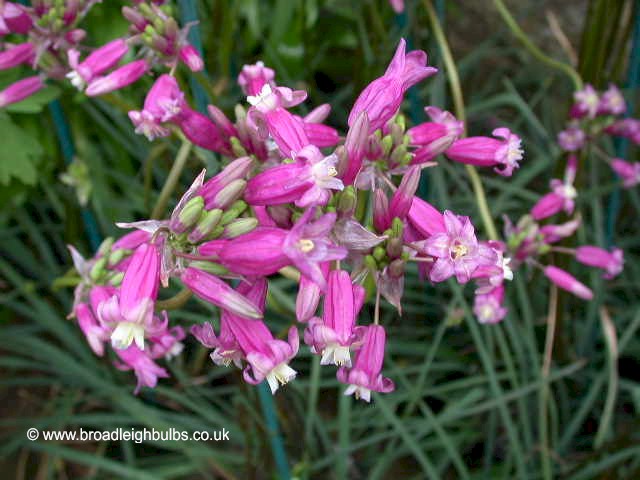 |
| Dichelostemma "Pink Diamond". A bit gaudier than Ida-maia but unusual enough to make it |
 |
| Gladiolus Saundersii |
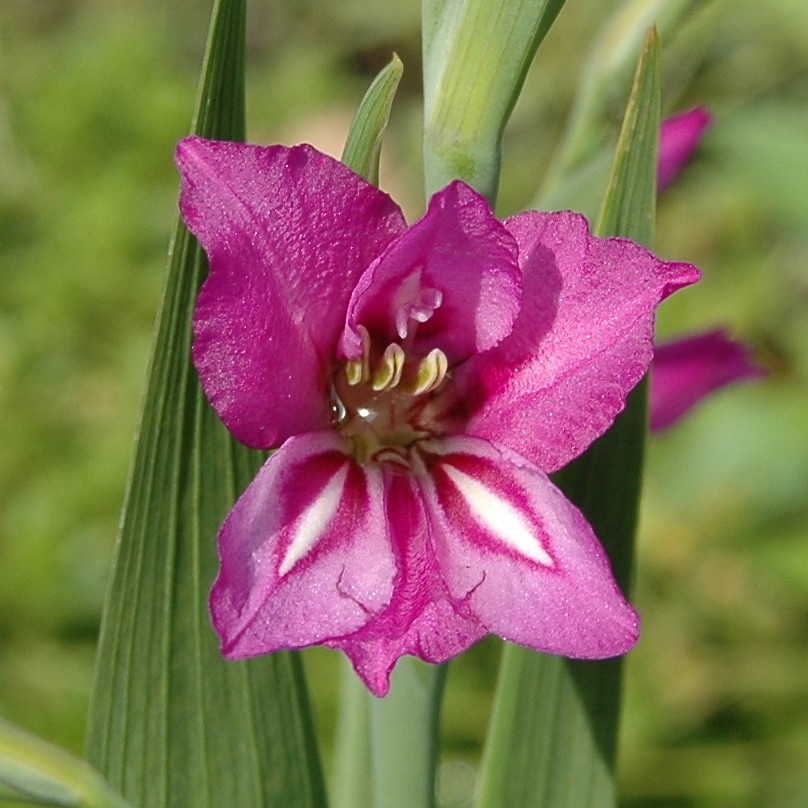 |
| G. imbricatus. A bit like the European species (magenta and not half as sexy as most South African Glads) |
 |
| Lilium sulphureum. Nothing special but very hard to get hold of so when the chance came up I snapped up a beautiful, chunky, purple bulb which certainly looks to be of flowering size. Fingers crossed |
Did I tell you I've got myself a couple of Eucomis bicolor? Well I have. And Gladiolus alba, Agapanthus "Peter Pan", Zantedeschia "Picasso", 10 yellow Tigridia (much classier than the usual mixture) and I've had it a while but haven't told you about my Diplarrhena moraea which is a totally hardy and stunning Phalaenopsis-like bulb. Stuff is arriving or maturing at an overwhelming rate and quite apart from the space issue is the fact I keep running out of pots. Terracotta pots are relatively cheap even at The Very Expensive Garden Centre in a fashionable area of north London (99p for 3in but 7.99 for an Achillea to which I wouldn't give garden room if I owned Canada), they're not very easy to move around london when you don't have a car. There is one company (thepotco.co.uk) that sells them at a really decent price (you have to wade through a load of expensive fancy shite to get to the simple pots) and delivers almost the next day but they come in enormous boxes that could easily be a new washing machine, not half a dozen 7in pots! You can have a metre square galvanised steel container for just £600 but a 13cm clay pot is 72p so unless you drive I'd thoroughly recommend them. They mould two halves of foam stuff round the pots that then fits in a huge cardboard box, meaning they arrive in perfect nick and leaving you with a waste disposal nightmare.
 |
| Agapanthus "Peter Pan" |
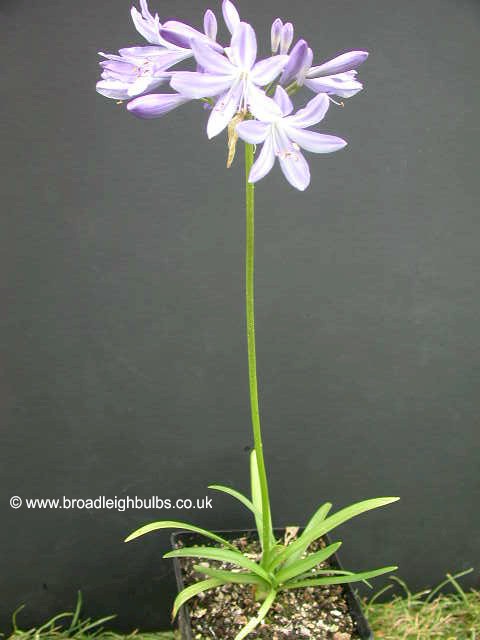 |
| I'd imagined something a bit more like this which is ironic because it was Broadleigh who sold it to me! They probably don't get too many people complaining that their bulb was too big. It will need dividing next year anyway so I shall have my wish. And about 20 bulbs to give away |
Peter Pan was a little bit of a disappointment as I had a picture in my mind of one bulb filling a little clay pot with one stem about a foot high with a miniature Agapanthus flower. But what actually arrived was a tangled, solid cube of roots with a few leaves at the the top indicating the presence below of at least half a dozen bulbs. I was very tempted to pull the whole thing apart into individual bulbs but it would have been like tearing an old telephone diretory in half. I then considered using a knife to slice the mass into more manageable chunks but I was worried I'd end up with a bunch of diced onions so I chickened out and settled for teasing out as many of the thick roots as possible to end up with more of a ball than a cube (it had obviously been growing in a square pot and forgotten about) and planting the whole thing in a much larger pot than I'd planned, leaving the top of the bulbs and the new leaves above the surface of the gritty compost. It will have to be tackled at some point as the centre will be crushed to death but I'll get some flowers out of it first!
 |
| Zantedeschia "Picasso" |
 |
| Diplarrhena moraea. Has the look of an orchid but a lot less upset by frost and other bothersome things, like being outside on a roof under six inches of snow |
.JPG) |
| Yellow Tigridia. I thought sticking to one colour might make them look a bit less vulgar than the packs of dried out mixtures from B&Q or Tesco |
I have seeds springing up all over the place but my indelible marker has proved to be anything but and I have at least three pots of lush, green babies with blank labels. I keep most of my used seeed packets for reference and tried to identify them by a process of elimination (at least they're dicots so the second set of leaves will hopefully give a clue but at the moment all I know is what they're not. The pot I thought was the new Delphinium species isn't, now that I've compared it to what I know to be D. nudicaule. Well, I like surprises but the Aspergers in me likes order. I'm sure time will tell but until then it is frustrating.
 |
| I have no idea what these are |
 |
| But these are definitely the beautiful red Delphinium nudicaule |
Coming up: My 30 or so varieties of Lily are beginning to do cool stuff, especially a group of containers containing those mighty hybrids including "Tiger Woods", which are a foot or so tall, and I've realised I have so many doubles (not that kind of double, unless you include "Flore Pleno" but I have three pots of L. martagon album but don't think I have the type. And at least 3 lancifolium. This is not counting seeds.
 |
| One of three pots of Lilium martagon album I've accidentally bought. I think I've got the type too. |
And the Fritillarias are on the verge of something very special indeed. Raddeana has burst through mightilly but will be a while in make-up before I can show it off. Others are a fortnight from perfection. You will be impressed!
 |
| It's hard to tell from this photo but that bud is about an inch wide |
 |
| Something interesting going on with F. stenanthera |
 |
| F. michailovskyi var. multiflora, very much in bud(s) |
Iris aucheri is on the verge of budding and while svetlanae is using this year to split in two and spend this season in the gym so next year should be very yellow. The other junos and arils are showing no signs of illness and are in fact in rude health, while the beardeds have taken on a bright green gloss over the last few weeks that must mean my TLC is going to pay off in the form of a display worthy of Monet's brush.
 |
| Iris aucheri in the rain today looking exactly like one in a book. I amaze myself |
 |
| That was a single rhizome with three leaves on it when it arrived from France last autumn. I think he likes me. All 15 or so have flourished but will they flower? You'll be the second to know. |
I just had to show you a couple of other things. You know that yellow Paeonia, mlokosewitschii?
It's going to bloom, it looks so happy! And finally, those stacking strawberry growers without the strawberries?
 |
| Primula maximowiczii and the Corydalis from the last post together in perfect harmony in one of the strawberry planters. So it's turning out to have been quite a smart purchase and I've sprinkled Dianthus knappii throughout both of them so hopefully they'll trial about looking pretty and yellow |
So the posts get longer and harder work the futher into the growing season we get. This took two days and it's mid-February. It will all be worth it when I win Rooftop Lily and Iris and some very odd stuff blogger of the year. Until then, may your gardens flourish, whatever their altitude.
The Plantboy























.JPG)








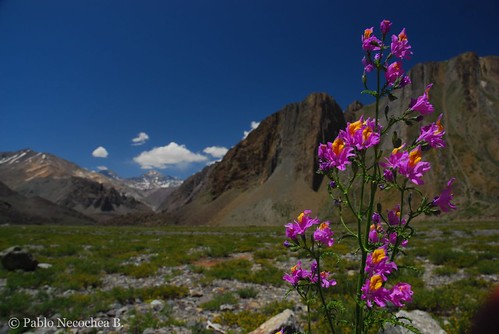











No comments:
Post a Comment